Acne scars and blemishes can be difficult to remove and take time and patience. There is no quick fix, but there are several approaches you can take to help improve the appearance of your skin over time, such as consulting a dermatologist, topical treatments, chemical peels, microneedling, laser therapy, microdermabrasion, dermal fillers, scar creams, sun protection, a healthy lifestyle, and patience. As if fighting acne wasn't difficult enough, consider the post-acne dark patch or pigmentation. The good news is that they are only temporary!
Skincare tips to treat pigmentation and scarring
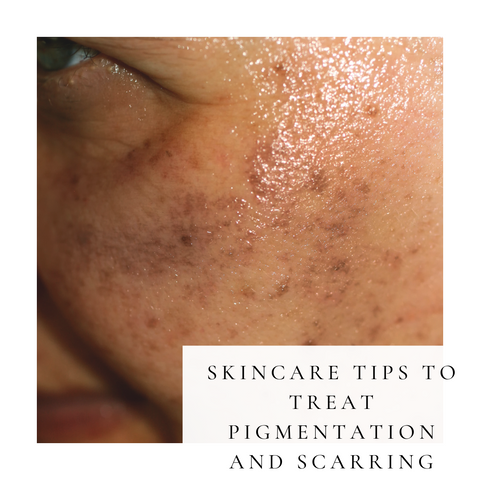
Treating pigmentation and scarring with your skincare routine necessitates a patient and delicate approach. Pigmentation is usually caused by an increase in melanin production in response to the inflammatory processes that occur during acne development. Sometimes it's simply out of control, resulting in a visible patch that can be really uncomfortable. Here are a few ideas for lowering it:
-
Wear sunscreen and reapply it frequently: This is one of the most important steps because it prevents further deterioration of the pigment caused by UV damage as well as the formation of new ones. Sunscreen should have an SPF of 30 or higher, as well as UVA and UVB protection.
-
Use a spot-lightening cream: Dermatologists recommend a variety of over-the-counter products for such marks. They appear to contain pigment-lightening agents such as glycolic acid, lactic acid, arbutin, kojic acid, glutathione, and others. Melanil Anti-Spot Cream and Clinikally Pigment Corrector Cream are two spot-lightening creams that dermatologists in India trust and recommend.
-
Report to a qualified dermatologist: if the pigmentation is stubborn. It may require some professional interventions with treatments such as peels, lasers, or a combination of them all. You can consult dermatologists online on Clinikally, and get personalised answers and solutions for scars, spots, and any other skin queries you might have.
-
Keep your skin hydrated: Finally, skin hydration is an important factor in helping the dark spot heal faster. Hence, one should indulge in a good grease-free healing moisturiser and use it regularly.
Skin Assessment
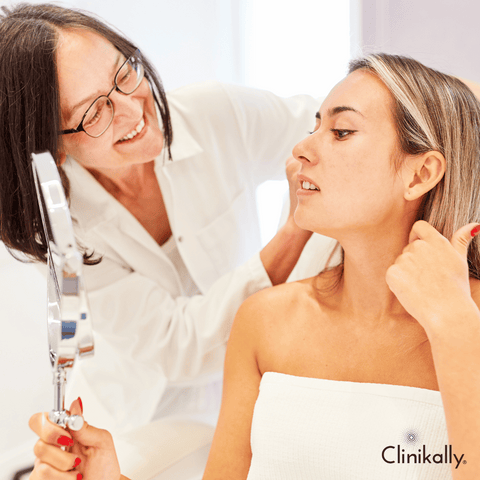
A skin assessment is a thorough examination of your skin's condition, health, and unique requirements. It can assist you in determining your skin type, identifying any concerns or issues, and developing a skincare programme tailored to your specific needs. Here's how to cleanse your skin, examine your skin type, and identify specific skin concerns, skin texture, pores, blemishes, pigmentation, sensitivity, fine lines and wrinkles, skin tone and complexion, environmental factors, and lifestyle factors. Following your skin examination, you can create a customised skincare routine and select products that meet your individual needs. Cleaning, moisturising, UV protection, and treatments customised to your skin type and issues are all part of a well-rounded skincare routine. It is important to remember that skin conditions can change over time as a result of factors such as aging, hormones, and lifestyle changes. As a result, it is a good idea to reassess your skin and adjust your skincare routine as needed. If you have specific concerns or persistent skin issues, you should seek professional advice and recommendations from a dermatologist.
The role of exfoliation in scar reduction
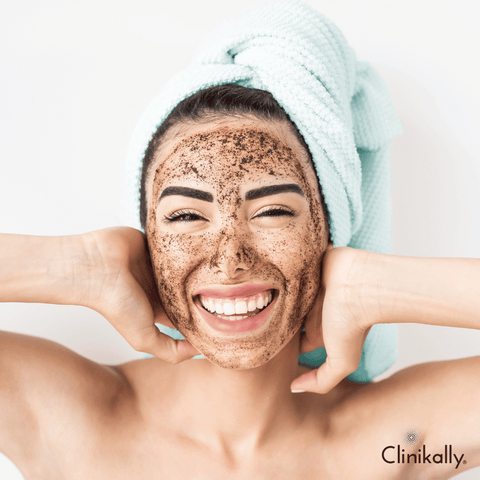
Exfoliation is important in scar removal, especially in the case of post-inflammatory hyperpigmentation (PIH) and specific types of scars, such as acne scars. Exfoliation can help scars look better by increasing skin cell turnover, lowering hyperpigmentation, and smoothing the skin's texture. Here's how exfoliating can help with scar reduction:
-
Dead Skin Cell Removal: Exfoliation, whether physical or chemical, aids in the removal of the top layer of dead skin cells. This procedure can make the skin appear smoother and more radiant, making scars less visible.
-
Increased Cell Turnover: Exfoliation stimulates the skin's production of new, healthy skin cells. By replacing damaged cells with new ones, this accelerated cell turnover can help fade scars over time.
-
Reduced Hyperpigmentation: Many scars are darker than the surrounding skin due to increased melanin production (hyperpigmentation). Exfoliation can help fade hyperpigmentation by shedding dark, damaged skin cells and encouraging the growth of lighter, healthier skin cells.
-
Improved Skin Texture: Exfoliation can also help to improve skin texture. Certain types of scars, such as raised or hypertrophic scars, can benefit from exfoliation to reduce unevenness and smooth out the scar tissue.
It is crucial to remember that exfoliation should be done cautiously and sparingly because severe or overzealous exfoliation can aggravate existing scars and cause skin irritation and redness. Your skin type and scar type should dictate the frequency and severity of exfoliation. A dermatologist can recommend the best exfoliating method and products for your skin type.
Benefits of vitamin C for skin healing

Vitamin C, commonly known as ascorbic acid, has numerous skin healing and skin health advantages. It is a potent antioxidant that is essential for many skin-related activities. Here are some of the most important advantages of vitamin C for skin healing:
-
Collagen Production is Increased: Vitamin C is required for the manufacture of collagen, a structural protein that gives the skin strength and flexibility. Collagen is essential for wound healing, scar formation, and skin rigidity. A sufficient supply of vitamin C can aid in the skin's capacity to mend and repair itself.
-
Wound Healing: Vitamin C promotes the body's natural wound-healing processes. It promotes the formation of new blood vessels (angiogenesis) and the production of connective tissue, which aids in the closure of wounds and reduces the risk of infection.
-
Reduces Inflammation: Anti-inflammatory properties of vitamin C can help soothe and calm irritated or inflamed skin. This is especially useful for conditions like sunburn or post-procedure redness.
-
Antioxidant Protection: Vitamin C is a powerful antioxidant that protects the skin from free radicals and environmental stressors like UV radiation and pollution. This antioxidant function can aid in the prevention of premature ageing, the reduction of oxidative stress, and the maintenance of healthy skin.
-
Hyperpigmentation and Scarring: By inhibiting melanin production and promoting an even skin tone, vitamin C can help fade hyperpigmentation, such as dark spots and acne scars.
-
Skin Brightening: Vitamin C can improve the appearance of dull, tired skin by making it appear brighter and more radiant.
-
UV Protection: While it should not be used in place of sunscreen, vitamin C can help your skin's defence against UV damage by neutralising free radicals produced by UV rays. It is most effective when combined with sunscreen for complete sun protection.
-
Moisturization: Vitamin C helps the skin retain moisture, which improves hydration.
-
Skin Barrier Support: Vitamin C can help to strengthen the skin's natural barrier function, which is important for maintaining skin health and preventing moisture loss.
-
Anti-Aging Benefits: Vitamin C can help reduce the appearance of fine lines and wrinkles and contribute to a more youthful complexion by protecting against free radicals and promoting collagen production.
You can add vitamin C to your skincare routine by using topical treatments such as serums or lotions. Look for products that contain stable forms of vitamin C, such as L-ascorbic acid, and utilise items that are appropriate for your skin type. It is critical to wear sunscreen every day since vitamin C can improve sun protection but does not eliminate the requirement for sunscreen to prevent UV damage. Furthermore, including vitamin C-rich foods in your diet might help your skin's health from within. Remember to seek personalised skincare advice and product recommendations from a dermatologist.
Home remedies for acne scars
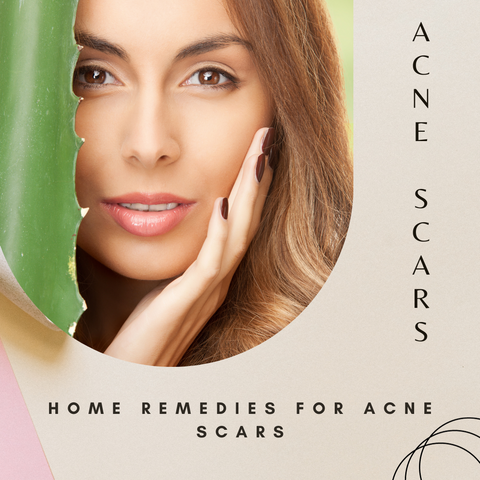
Home remedies for acne scars might be a cost-effective and natural solution to improve your skin's appearance. However, it is crucial to note that these therapies may not fully eradicate scars, especially if the scarring is deep or severe. You can try the following home remedies:
-
Lemon Juice: Lemon juice contains vitamin C, which can aid in lightening dark spots and hyperpigmentation. Apply freshly squeezed lemon juice to scars and leave on for 10-15 minutes before rinsing. When heading outside, wear sunscreen because lemon juice might make your skin more vulnerable to UV rays.
-
Honey: Honey offers antimicrobial and therapeutic effects that are natural. Apply a thin layer of honey to the scarred area and let it sit for 15-20 minutes before rinsing with warm water.
-
Aloe Vera: Aloe vera is well-known for its healing and calming capabilities. Apply pure aloe vera gel to scars and leave on for 30 minutes. This is something you can do on a daily basis.
-
Coconut Oil: Coconut oil contains fatty acids, which help to moisturise and soften the skin. Massage the scars lightly with a tiny amount of pure coconut oil. After a few hours, you can either leave it on or wash it off.
-
Rosehip Seed Oil: Rosehip seed oil is high in antioxidants and vital fatty acids. It can aid in the regeneration of skin and the reduction of scars. Apply a few drops on the scars and gently massage them in.
-
Apple Cider Vinegar: Dilute apple cider vinegar with water (1 part vinegar to 3 parts water) and apply it to the scars using a cotton ball. Allow a few minutes before rinsing with water. It should be used with caution because it might be severe.
-
Baking Soda: Make a mixture of baking soda and water and apply it to the scars carefully. After a few minutes, rinse with warm water. This exfoliating treatment should only be used once a week.
-
Green Tea: Green tea is high in antioxidants, which can aid in skin repair. Allow a cup of green tea to cool before applying it to your scars with a cotton ball.
-
Turmeric: Turmeric is anti-inflammatory and skin-brightening. Apply a paste made of turmeric and water to the scars. Leave it on for 10-15 minutes before rinsing.
-
Lavender Oil: Lavender oil offers naturally rejuvenating qualities for the skin. Apply it to your scars after diluting it with a carrier oil (such as coconut or jojoba).
Remember that the effectiveness of home remedies varies from person to person and that considerable benefits may take time to manifest. Also, if you have sensitive skin or suffer any negative reactions, stop using it. Consult a dermatologist if you have severe or deeply pitted scars or if you aren't getting the results you want. For more effective scar reduction, they can offer expert treatments such as chemical peels, microdermabrasion, or laser therapy.
Using aloe vera gel for skin repair

Aloe vera gel is a popular natural skin repair solution that has been used for generations because of its soothing and healing characteristics. It includes several bioactive chemicals that are beneficial to the skin. Here's how to use aloe vera gel for skin repair, including sunburn relief, minor burns and wound healing, moisturiser, acne and blemishes, anti-aging, mild skin irritations, and post-procedure skin healing. Follow these instructions to utilise aloe vera gel for skin repair:
-
Use a little soap and water to clean the impacted area.
-
Apply a generous amount of pure aloe vera gel to the affected area. You can use either freshly extracted aloe vera gel or store-bought gel.
-
Allow the gel to penetrate the skin. It is not necessary to rinse it.
It should be noted that some people are sensitive or allergic to aloe vera. Perform a patch test on a small, inconspicuous area of your skin before applying it to a larger area to ensure you do not have an allergic reaction.
Turmeric and honey mask for brightening

A turmeric and honey mask is a well-known natural therapy for skin lightening. Honey is a natural humectant that can moisturise and soothe the skin, while turmeric includes curcumin, which has anti-inflammatory and antioxidant qualities. They can help enhance skin tone, reduce inflammation, and promote a healthy, bright complexion when used together. Here's how you make and apply a turmeric and honey lightening mask:
Ingredients: 1 teaspoon turmeric powder (organic preferred) and 1 tablespoon organic raw honey
Instructions:
-
Cleanse Your Face: Begin with a clean face. Remove any makeup, dirt, or impurities with a gentle cleanser. Using a clean towel, pat your face dry.
-
Make the Mask: Combine the turmeric powder and honey in a small mixing bowl. Mix until a smooth, consistent paste forms. To achieve the desired consistency, adjust the honey/turmeric ratio.
-
Patch Test: Before applying the mask to your entire face, perform a patch test on a small area of your skin to ensure you do not have an allergic reaction or sensitivity to the ingredients.
-
How to Use the Mask: Apply the mask evenly to your face, avoiding the eye area, with clean fingers or a brush. Use caution when using turmeric, as it can temporarily stain the skin yellow.
-
Relax: Let the mask remain on your skin for ten to fifteen minutes. It is normal for you to experience a slight warming during this time.
-
Rinse Off: After the recommended time has passed, thoroughly rinse the mask with lukewarm water. It may be necessary to use a gentle cleanser to remove any remaining yellow stains.
-
Moisturise: After removing the mask, apply your favorite moisturiser to your skin to keep it hydrated.
-
Sunscreen: If you use this mask during the day, make sure to apply sunscreen afterward because turmeric can make your skin more sensitive to UV rays.
Lemon juice: A natural bleaching agent
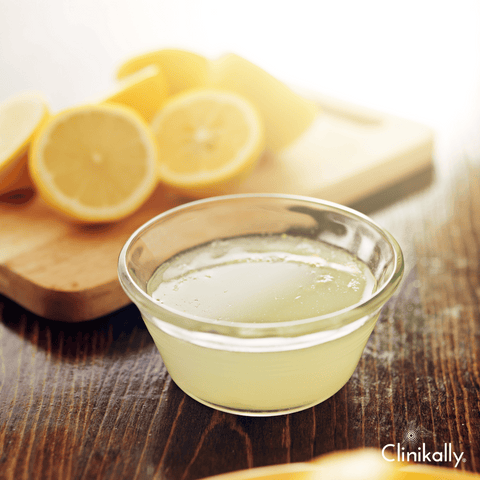
Lemon juice is frequently used as a natural bleaching agent due to its acidic and citric qualities. It includes citric acid, which has a slight lightening impact on the skin and is often used to treat hyperpigmentation, dark spots, and uneven skin tone. Here's how lemon juice works as a natural bleaching agent:
-
Skin Brightening: The citric acid in lemon juice can help exfoliate the top layer of skin by breaking down dead skin cells, allowing for the emergence of newer, brighter skin cells. This procedure can produce a more radiant and even skin tone.
-
Reduction of Hyperpigmentation: Melasma, sun spots, and age spots are examples of hyperpigmentation that can be effectively minimised with lemon juice. Citric acid may inhibit the synthesis of melanin, which gives skin its colour.
-
Acne Scars: Applying lemon juice on a regular basis can help reduce the post-inflammatory hyperpigmentation (PIH) caused by acne. It may encourage scars and dark marks to lighten.
-
Natural Skin Toner: Lemon juice has the ability to naturally tone and astringent. It can help tone and tighten the skin, giving it a more radiant, youthful appearance.
Use lemon juice application, patch testing, sun protection, consistency, and caution while using lemon juice as a natural bleaching agent. It's crucial to remember that lemon juice isn't a quick remedy, and its effectiveness varies from person to person. Furthermore, if you have severe skin problems or recurrent skin disorders, you should get expert advice and recommendations from a dermatologist.
Medical treatments for acne scars and blemishes
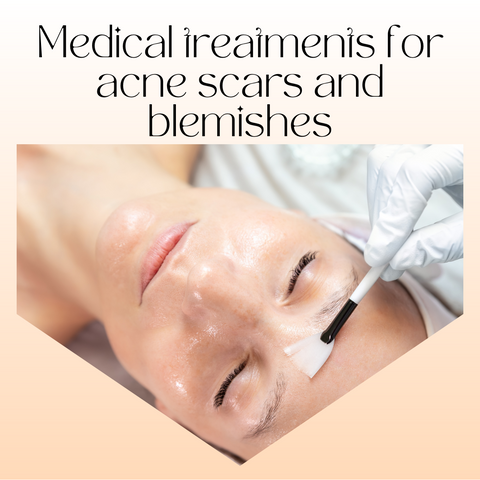
Medical treatments for acne scars and blemishes are frequently more successful than home therapies and can significantly enhance skin appearance. The type of scar, its severity, and personal characteristics all influence treatment options. Some typical medical treatments for acne scars and blemishes include:
-
Chemical Peels: Using an acid solution, a chemical peel removes the outermost layer of skin, exposing skin that is smoother and more evenly toned. They can assist with blemishes and scars from mild to moderate acne.
-
Microdermabrasion: A machine with abrasive tips is used to exfoliate the outermost layer of skin. It can enhance the look of minor acne scars and imperfections and is less intrusive than chemical peels.
-
Dermal Fillers: In order to bring depressed acne scars level with the surrounding skin, dermal fillers such as collagen or hyaluronic acid can be injected. This works well in the treatment of atrophic scars.
-
Microneedling: Microneedling is the controlled creation of microscopic skin injuries using tiny needles. This works well for acne scars because it increases the production of collagen and can smooth out the skin's texture.
-
Laser Therapy: By resurfacing the skin, several laser treatments, including intense pulsed light (IPL) and fractional laser, can increase the production of collagen and improve the appearance of acne scars. More severe scars are frequently treated with laser therapy.
-
Radiofrequency Microneedling: This technique enhances skin texture and stimulates the production of collagen by combining microneedling with radiofrequency energy. It may work well for skin tightening as well as acne scars.
-
Subcision: Subcision is a minimally invasive surgical technique in which the fibrous bands holding atrophic scars to deeper tissues are broken up with a needle. This makes the scar look better by lifting it.
-
Punch excision: This procedure entails using a tiny punch tool to remove the scar tissue from deep icepick or boxcar scars, then suturing the skin shut. Several scar treatments frequently come after this.
-
TCA Cross: To encourage skin peeling and collagen production, trichloroacetic acid (TCA) is directly applied to ice-pick scars.
-
Injections of corticosteroids: These are used to treat keloid or hypertrophic scars. In order to reduce inflammation and flatten the tissue, corticosteroids are injected directly into the scar.
-
Silicone Sheeting: Silicone sheets are used to hydrate and flatten scar tissue. They can help with both hypertrophic and atrophic scars.
-
Autologous Fat Transfer: In this procedure, fat is extracted from one part of the body and injected into depressed acne scars in order to bring them to the skin's surface.
-
PRP (Platelet-Rich Plasma) Therapy: PRP is a growth factor-rich plasma derived from your own blood that can stimulate collagen production and promote skin healing. It is frequently used in conjunction with other therapies.
To determine the best treatment for your specific scar type and skin condition, consult a dermatologist or medical professional. They can make personalised recommendations and create a treatment plan that is tailored to your specific needs.
Laser therapy for scar removal

Scar reduction with laser therapy is a common and effective medical treatment. It targets and breaks away scar tissue with targeted laser radiation, resulting in smoother, more even-textured skin. There are various types of laser treatments available, and the type and severity of the scar determine which laser is used. Here's a rundown of how laser therapy for scar reduction works:
Scar Removal Laser Therapy Types:
-
Fractional Laser Resurfacing: Fractional lasers create tiny, evenly spaced micro-injuries in the skin while leaving the surrounding skin intact. This stimulates the body's natural healing response and collagen production, which aids in scar reduction. Fractional laser treatment is effective for a variety of scars, including acne scars and surgical scars.
-
PDL (Pulsed Dye Laser): PDL is frequently used to treat red or raised scars such as hypertrophic scars and keloids. It works by targeting the blood vessels that cause the redness in these scars, resulting in less redness and flattening of the scar.
-
CO2 Laser: CO2 lasers are used to treat more severe scarring, such as deep acne scars and atrophic scars. These lasers remove thin layers of skin from the scarred area in order to smooth and resurface it. CO2 lasers may require a longer recovery period and more downtime than other laser treatments.
How Laser Therapy Works for Scar Removal:
-
Consultation: Your dermatologist or healthcare practitioner will assess your scar and skin type to identify the best laser therapy for you. They will discuss your objectives, describe the procedure, and provide information on potential risks and benefits.
-
Preparation: Your skin will be properly cleaned before the operation, and a topical numbing lotion or local anaesthesia may be administered to minimise discomfort.
-
Laser Treatment: The laser is directed at the scar tissue during the process. The device may provide energy pulses or build microscopic channels in the skin, depending on the type of laser. This increases collagen production and supports scar tissue replacement with healthy skin cells.
-
Post-Treatment Care: Following the procedure, it is essential that you follow your healthcare provider's post-treatment instructions. You may suffer redness, swelling, and soreness, which should go away in a few days. It is critical to use appropriate skincare products and protect your skin from sun exposure.
Chemical peels and their effectiveness
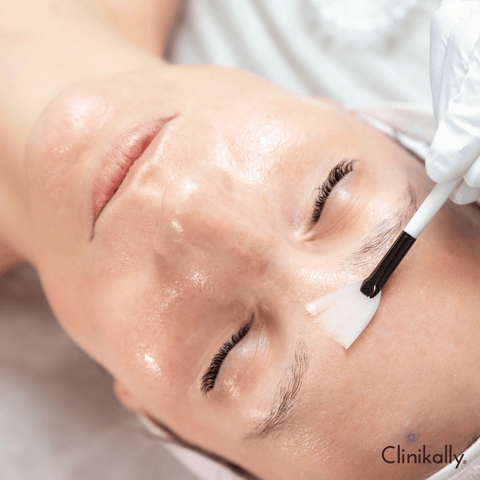
Chemical peels are cosmetic treatments that exfoliate the top layer of the skin with various chemical solutions. They are frequently used to improve the texture of the skin, minimise the appearance of fine lines and wrinkles, and treat conditions such as acne scars, pigmentation, and sun damage. The type of peel used, the depth of penetration, and the specific skin issues addressed all influence the effectiveness of a chemical peel. Here's a rundown of chemical peels and their efficacy:
Chemical Peels are classified into the following types:
-
Superficial (Light) Peels: These peels contain gentle acids such as alpha hydroxy acids (AHAs), beta hydroxy acids (BHAs), or fruit acids. They are primarily used for mild exfoliation, skin brightening, and skin texture improvement. Superficial peels require little downtime and are appropriate for all skin types.
-
Medium Peels: Stronger acids, such as trichloroacetic acid (TCA), are used in medium peels. They penetrate deeper into the skin, addressing more visible issues such as fine lines, moderate pigmentation, and acne scarring. Medium peels may experience some redness and peeling for a few days.
-
Deep Peels: Deep peels make use of phenol or high TCA concentrations. They penetrate deeply into the skin and are most effective at treating severe skin issues such as deep wrinkles and sun damage. Deep peels frequently necessitate longer recovery times and may not be appropriate for all skin types.
Effectiveness:
-
Improving Skin Texture: Chemical peels exfoliate the skin, remove dead skin cells, and promote smoother, more even skin texture. Superficial and medium peels are frequently used for this purpose.
-
Reducing Fine Lines and Wrinkles: Medium and deep chemical peels can help reduce the appearance of fine lines and wrinkles by stimulating collagen production and increasing skin firmness.
-
Treating Hyperpigmentation: Chemical peels, particularly medium and deep peels, can be effective in reducing hyperpigmentation, such as sunspots, age spots, and melasma. They work by lightening dark spots and promoting skin tone uniformity.
-
Acne Scar Improvement: By exfoliating the top layer of skin and stimulating collagen production, chemical peels, particularly medium and deep peels, can help improve the appearance of shallow acne scars.
-
Minimising Enlarged Pores: By exfoliating the skin and reducing its size, superficial chemical peels can improve the appearance of enlarged pores.
-
Sun Damage Repair: Chemical peels can help to repair sun-damaged skin by removing damaged surface layers and encouraging the growth of healthier skin.
Microneedling: Stimulating skin to heal itself

Microneedling is a cosmetic technique in which small needles are used to induce controlled micro-injuries in the skin. The procedure boosts the body's natural healing response and fosters skin repair and regeneration. Microneedling is a common therapy for a range of skin issues, and it is frequently used to improve skin look and texture. Specialised equipment with fine needles is used to make tiny, controlled punctures in the skin during the microneedling process. These micro-injuries are created precisely and uniformly. The micro-injuries activate the body's natural wound-healing mechanism. As a result, the treated area's collagen and elastin production increases. These proteins are necessary for the skin to retain its firmness, elasticity, and youthful appearance. The skin starts to rejuvenate and heal itself, resulting in better texture, fewer fine lines and wrinkles, and a more even skin tone. Because new collagen and elastin fibres fill in and smooth out uneven skin, microneedling can also aid with scar reduction, especially acne scars. The Advantages of Microneedling:
-
Improved Skin Texture: Microneedling can help improve the texture of the skin, making it smoother and softer.
-
Reduction of Fine Lines and Wrinkles: Microneedling can reduce the appearance of fine lines and wrinkles by stimulating collagen production.
-
Acne Scar Reduction: Microneedling is an effective treatment for reducing the appearance of acne scars, especially atrophic and depressed scars.
-
Improved Pigmentation: It can help fade hyperpigmentation, melasma, and sunspots, resulting in more even skin tone.
-
Pore Reduction: Microneedling can reduce the appearance of enlarged pores, making the skin appear smoother.
-
Product Absorption is Improved: The microchannels formed during microneedling allow for better absorption of topical skincare products, making them more effective.
-
No Downtime: Depending on the depth and intensity of the treatment, there may be minimal downtime, making it a convenient option for many people.
Professional microneedling treatments are usually more effective and use medical-grade equipment. However, there are at-home microneedling devices available that are less expensive but may have depth and precision limits. When considering at-home microneedling, it is critical to exercise caution and adhere to safety recommendations. When conducted by a licenced and skilled specialist, microneedling is usually regarded as a safe operation. The type of microneedling used, as well as the number of sessions needed, are determined by the individual's skin issues and the desired results. To identify the best microneedling treatment plan for your skin, visit a physician or skincare specialist.
















